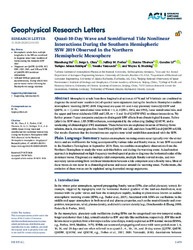Quasi‐10‐Day Wave and Semidiurnal Tide Nonlinear Interactions During the Southern Hemispheric SSW 2019 Observed in the Northern Hemispheric Mesosphere
He, Maosheng; Chau, Jorge L.; Forbes, Jeffrey M.; Thorsen, Denise; Li, Guozhu; Siddiqui, Tarique Adnan; Yamazaki, Yosuke; Hocking, Wayne K., 2020: Quasi‐10‐Day Wave and Semidiurnal Tide Nonlinear Interactions During the Southern Hemispheric SSW 2019 Observed in the Northern Hemispheric Mesosphere. In: Geophysical Research Letters, Band 47, 23, DOI: 10.23689/fidgeo-4076.
 |
Dokument öffnen: |
Mesospheric winds from three longitudinal sectors at 65°N and 54°N latitude are combined to diagnose the zonal wave numbers (m) of spectral wave signatures during the Southern Hemisphere sudden stratospheric warming (SSW) 2019. Diagnosed are quasi‐10‐ and 6‐day planetary waves (Q10DW and Q6DW, m = 1), solar semidiurnal tides with m = 1, 2, 3 (SW1, SW2, and SW3), lunar semidiurnal tide, and the upper and lower sidebands (USB and LSB, m = 1 and 3) of Q10DW‐SW2 nonlinear interactions. We further present 7‐year composite analyses to distinguish SSW effects from climatological features. Before (after) the SSW onset, LSB (USB) enhances, accompanied by the enhancing (fading) Q10DW, and a weakening of climatological SW2 maximum. These behaviors are explained in terms of Manley‐Rowe relation, that is, the energy goes first from SW2 to Q10DW and LSB, and then from SW2 and Q10DW to USB. Our results illustrate that the interactions can explain most wind variabilities associated with the SSW. Plain Language Summary:
Sudden stratospheric warming events occur typically over the winter Arctic and are well known for being accompanied by various tides and Rossby waves. A rare SSW occurred in the Southern Hemisphere in September 2019. Here, we combine mesospheric observations from the Northern Hemisphere to study the wave activities before and during the warming event. A dual‐station approach is implemented on high‐frequency‐resolved spectral peaks to diagnose the horizontal scales of the dominant waves. Diagnosed are multiple tidal components, multiple Rossby normal modes, and two secondary waves arising from nonlinear interactions between a tide component and a Rossby wave. Most of these waves do not occur in a climatological sense and occur around the warming onset. Furthermore, the evolution of these waves can be explained using theoretical energy arguments. Key Points:
Mesospheric winds from multiple longitudes in the NH are combined to diagnose zonal wave numbers of waves during the Antarctic SSW 2019.
Diagnosed are Q6DW, Q10DW, M2, SW1, SW2, SW3, and LSB and USB of Q10DW‐SW2 nonlinear interactions.
LSB and USB are generated asynchronously, during which their parent waves evolve following the Manley‐Rowe energy relations.
Statistik:
ZugriffsstatistikSammlung:
Schlagworte:
sudden stratospheric warming (SSW)semidiurnal tides
nonlinear interactions
quasi‐10‐day wave
quasi‐6‐day wave
Manley‐Rowe relation
This is an open access article under the terms of the Creative Commons Attribution‐NonCommercial License, which permits use, distribution and reproduction in any medium, provided the original work is properly cited and is not used for commercial purposes.

